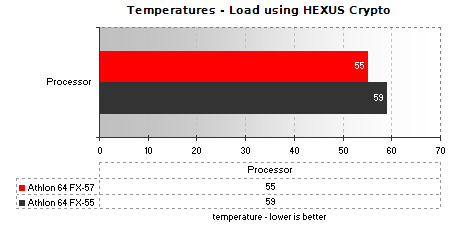System Setup and Notes, Overclocking
Test Platforms
| System | Intel Pentium (4) System | AMD Athlon 64 System |
| Processor(s) | Pentium 4 530J Pentium 4 570J Pentium 4 670 Pentium D 820 Pentium XE 840 |
AMD Athlon 64 FX-57 Athlon 64 3000+ Athlon 64 3500+ Athlon 64 4000+ Athlon 64 FX-55 Athlon 64 X2 4800+ |
| Mainboards | Intel D955XBK i955XE | DFI LanPartyUT nF4 SLI-D for FX-57 ASUS AN8-SLI for X2 4800+ ABIT Fatal1ty AN8 nForce4 Ultra for all others |
| Memory | 2 x 512MB Corsair XMS2-5400UL | 2 x 512MB Corsair Xpert XL DDR-400 |
| Timings | 3-2-2-8 @ 533MHz | 2-2-2-5 @ 400MHz |
| BIOS Version | BK95510J.86A.1452.EB | BIOS 10/3/2005 for DFI LanParty BIOS -13 for ABIT AN8 BIOS 23/03/05 for ASUS A8N-SLI |
| Disk Drive | 300GB Maxtor SATA for DFI LanParty 160GB Western Digital PATA for all others |
|
| Graphics Card | ATI RADEON X850 XT PE CATALYST 5.3 |
|
| Operating System | Windows XP Professional, SP2 | |
| Mainboard Software | Intel INF Update Utility 7.0.0.1019 | NVIDIA nForce4 Platform Driver 6.39 |
Benchmark Software
HEXUS.in-house Cryptography Benchmark
HEXUS Pifast Benchmark
ScienceMark 2.0 (7th February 2005)
Realstorm 2004
CINEBENCH 2003
HEXUS.in-house MP3 Encoding Benchmark using LAME 3.97a (Intel HT compiler) - 701MB WAV
Microsoft Movie Maker 2.1
picCOLOR 32-bit v4.0
KribiBench v1.1
3DMark2001SE b330
UT2003 - HEXUS custom bot test
DOOM 3 v1282
Far Cry v1.3
Notes
The FX-57 was benchmarked using DFI's LanParty UT nF4 SLI-D mainboard whereas the majority of the Athlon 64 benchmarking was done using ABIT's AN8 Fatality under the watchful eye of HEXUS's Review's Editor, Tarinder. Athlon 64 X2 4800+ numbers were run on the A8N-SLI mainboard we used to evaluate it on launch. A mismatch of mainboards but thankfully all other components bar the hard disk drives are the same (and we have no disk-bound benchmarks). Bear the mainboard differences in mind when comparing benchmark results, no matter whether the difference would be within the bound of statistical noise or not.Our mainly single-threaded benchmark suite was used to evaluate the performance of all 11 CPUs, an ATI graphics card drew all the pixels on the screen and Windows XP with Service Pack 2 provided the operating system platform.
FX-57 seems to run cooler than Clawhammer-based FX-55 under load. I've run FX-55 in this DFI-based system for months prior to the FX-57 arriving for this review and using an Akasa Evo33 cooler, FX-57 at 2800MHz runs a few degrees cooler under load than the 2600MHz FX-55. Hilariously, the DFI's BIOS identified the new CPU as an Athlon 64 FX-25.
Temperatures
Load temperatures were measured using a custom build of my HEXUS Crypto benchmark that loops infinitely over the dataset, encrypting data continuously until asked to stop. Both CPUs were allowed to run loaded for 30 mins before a temperature reading using a digital thermometer was taken.
Remember, the FX-57 was at 2800MHz using 1.36V while the FX-55 was at 2600MHz using 1.52V.
CPU-Z Information
CPU-Z InformationValidated CPU at x86-secret.com
Overclocking
I'll write a separate article in due course about overclocking San Diego with FX-57. Without giving the game away, there's silly headroom with the new CPU when you cool it with something a bit more potent than an air cooler, with a mainboard as able as the DFI LanParty nF4 series of mainboards.Air-cooled overclocking stopped around 3100MHz using 1.45V, with a round 15 x 200 a very stable 24/7 setting using the Akasa Evo33 in my usual Akasa Eclipse-62 chassis, loaded with the near-silent orange Akasa fans.
3000MHz was perfectly fine at stock voltage, using the week 12 '05 FX-57 review sample. Here's a shot of that emulated FX-59, should that CPU ever come to pass with one notch higher on the multiplier, using a 90nm San Diego core. I'll show you emulated 'FX-63' and 'FX-65' in the fullness of time, such is the FX-57's willingness to go faster with phase-change.










